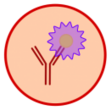
Secondary Antibodies
Secondary Antibodies are immunoglobulins that are specific for a primary antibody. They are produced by immunizing the host animal with antibodies from another species. Secondary antibodies are used in indirect detection, and are typically bound to some type of detection molecule such as a fluorophore, enzyme or protein.
Which Secondary Antibody?
When selecting a secondary antibody, there are a few things to keep in mind:
- The secondary antibody should recognize the host species and isotype of the primary antibody
- Which type of detection molecule best fits your experiment
Popular Applications
Why Reddot Antibodies?
When you choose Reddot Biotech products, you’re choosing high quality, research-ready reagents specifically designed to help your experiments succeed. We believe in supporting scientists on their way to the next big breakthrough to make the world a better place. If you have any questions or concerns, or just want some advice, we are always here to help.
Antibody Resources
Performance Guarantee
All Reddot Biotech antibodies come with a performance quality guarantee. Contact us if you are unsatisfied with your product.
Need Technical Support?
Contact us for assistance or advice.



